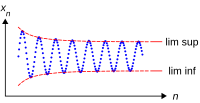Mathematics of oscillation

Imagine you are sitting on a swing in a playground, moving back and forth. This movement you are making is called oscillation. In mathematics, oscillation means movement that happens regularly or repeatedly around a central point.
When you swing back and forth, you start from one end, then move all the way to the other end, and then come back again. This movement repeats itself over and over in a predictable pattern. That pattern is called a cycle. The time it takes for one complete cycle to happen is called the period.
Now, if you swing back and forth faster, the period will be shorter, and if you swing slower, the period will be longer. This relationship between the swing's speed and its period is called the frequency.
In math, we use some fancy equations to describe oscillation. These equations use concepts like sin and cos (short for sine and cosine) to describe the shape of the pattern you make when you oscillate.
Aside from swings, oscillation can be found in many other things like sound waves, light waves, and even the movement of atoms. Studying the mathematics of oscillation helps us understand patterns in nature and make things that rely on these patterns, like musical instruments and clocks.
When you swing back and forth, you start from one end, then move all the way to the other end, and then come back again. This movement repeats itself over and over in a predictable pattern. That pattern is called a cycle. The time it takes for one complete cycle to happen is called the period.
Now, if you swing back and forth faster, the period will be shorter, and if you swing slower, the period will be longer. This relationship between the swing's speed and its period is called the frequency.
In math, we use some fancy equations to describe oscillation. These equations use concepts like sin and cos (short for sine and cosine) to describe the shape of the pattern you make when you oscillate.
Aside from swings, oscillation can be found in many other things like sound waves, light waves, and even the movement of atoms. Studying the mathematics of oscillation helps us understand patterns in nature and make things that rely on these patterns, like musical instruments and clocks.
Related topics others have asked about:
